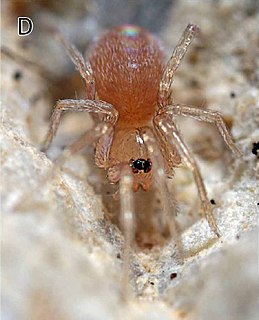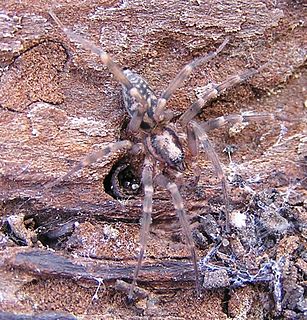
Oonopidae, also known as goblin spiders, is a family of spiders consisting of over 1,600 described species in about 113 genera worldwide, with total species diversity estimated at 2000 to 2500 species. The type genus of the family is OonopsKeyserling, 1835.

{{underreferenced}|date=February 2021}}

Ant spiders are members of the family Zodariidae. They are small to medium-sized eight-eyed spiders found in all tropical and subtropical regions of South America, Africa, Madagascar, Australia-New Guinea, New Zealand, Arabia and the Indian subcontinent. Most species are daytime hunters and live together with ants, mimicking their behavior and sometimes even their chemical traits. Although little is known about most zodariids, members of the genus Zodarion apparently feed only on ants; a number of other genera in the family are apparently also ant specialists.

Liocranidae is a family of araneomorph spiders first described by Eugène Simon in 1897. They are one of several groups called "sac spiders". The holarctic genus Agroeca is the best-known, but it also includes various genera of more obscure spiders that still lack a diagnosis. Two species in the North American genus Neoanagraphis are found in the extremely dry conditions in the Mojave, Sonoran and Chihuahuan deserts. Females live in animal burrows while males wander and are the ones most often caught in pitfall traps.

Wandering spiders (Ctenidae) are a family of spiders that includes the Brazilian wandering spiders. These spiders have a distinctive longitudinal groove on the top-rear of their oval carapace similar to those of the Amaurobiidae. They are highly defensive and venomous nocturnal hunters. Despite their notoriety for being dangerous, only a few members of Phoneutria have venom known to be hazardous to humans, but the venoms of this family are poorly known, so all larger ctenids should be treated with caution.

Onomastus is a genus of Asian jumping spiders that was first described by Eugène Louis Simon in 1900. It is the only genus in the subfamily Onomastinae.
Orchestina is a spider genus in the family Oonopidae. There are 71 accepted extant species in the genus.

The genus Oxytate, commonly known as grass crab spiders, comprises a homogenous group of nocturnal crab spiders. The complete mitochondrial genome of the type species O. striatipes was determined in 2014.

Mallinella is a genus of spider in the family Zodariidae.
Oedignatha is a genus of Asian spiders first described by Tamerlan Thorell in 1881 as a genus of corrinid sac spiders, and moved to Liocranidae in 2014.
Hermippus is a genus of ant eating spiders in the family Zodariidae, containing twelve species restricted to Asia and parts of Africa. Three new species were discovered in 2014.
Suffasia attidiya, is a species of spider of the genus Suffasia. It is endemic to Sri Lanka. The species was documented only from female specimens found from Bellanwila-Attidiya marsh, situated on the south-eastern outskirts of Colombo. The first male specimen was found in 2005.
Suffasia mahasumana, is a species of spider of the genus Suffasia. It is endemic to Sri Lanka.
Atypena is a genus of Asian dwarf spiders that was first described by Eugène Louis Simon in 1894.
Brignolia is a genus of goblin spiders in the family Oonopidae, containing thirty one accepted species.
Epidius is a genus of crab spiders that was first described by Tamerlan Thorell in 1877. It is a senior synonym of Pothaeus.






